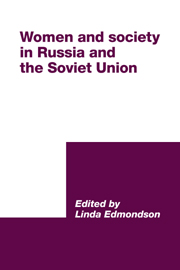Book contents
- Frontmatter
- Contents
- Notes on contributors
- Preface
- Introduction
- 1 ‘Better halves’? Representations of women in Russian urban popular entertainments, 1870-1910
- 2 The Silver Age: highpoint for women?
- 3 Women pharmacists in Russia before World War I: women's emancipation, feminism, professionalization, nationalism and class conflict
- 4 Women's rights, civil rights and the debate over citizenship in the 1905 Revolution
- 5 Laying the foundations of democracy in Russia: E. D. Kuskova's contribution, February–October 1917
- 6 Mariia L. Bochkareva and the Russian amazons of 1917
- 7 Russian women writers: an overview. Post-revolutionary dispersion and adjustment
- 8 Victim or villain? Prostitution in post-revolutionary Russia
- 9 Young women and perestroika
- 10 Glasnost and the woman question
- Index
10 - Glasnost and the woman question
Published online by Cambridge University Press: 22 October 2009
- Frontmatter
- Contents
- Notes on contributors
- Preface
- Introduction
- 1 ‘Better halves’? Representations of women in Russian urban popular entertainments, 1870-1910
- 2 The Silver Age: highpoint for women?
- 3 Women pharmacists in Russia before World War I: women's emancipation, feminism, professionalization, nationalism and class conflict
- 4 Women's rights, civil rights and the debate over citizenship in the 1905 Revolution
- 5 Laying the foundations of democracy in Russia: E. D. Kuskova's contribution, February–October 1917
- 6 Mariia L. Bochkareva and the Russian amazons of 1917
- 7 Russian women writers: an overview. Post-revolutionary dispersion and adjustment
- 8 Victim or villain? Prostitution in post-revolutionary Russia
- 9 Young women and perestroika
- 10 Glasnost and the woman question
- Index
Summary
Glasnost was initially conceived by Gorbachev as a necessary means to the end of perestroika, and as relative to it. His heightened conviction that glasnost was integral to the reform process was reflected in the Resolution on Glasnost adopted at the 19th Party Conference in 1988. Glasnost was praised as a ‘sharp weapon of perestroika’ which helped people ‘better to understand their past and present’ and objectively ‘to assess the situation in the country’. Glasnost was a vital part of ‘socialist self-government’ and its extension was essential for democratization and for the ‘renewal of socialism’. Moreover, every citizen enjoyed ‘the inalienable right to obtain complete and reliable information on any social question’ that was not a state or military secret and ‘the right to open and free discussion of any socially significant issue’. Although by 1990 the consequences of glasnost in the republics had outstripped perestroika, Gorbachev's commitment to glasnost endured, even if he was bewildered, exasperated and provoked by some of its results. Glasnost remained crucial to his vision of socioeconomic and political change, but after 1990 with growing and contradictory qualifications.
The application of glasnost, however, has not been homogeneous across issues in content or pace.
- Type
- Chapter
- Information
- Women and Society in Russia and the Soviet Union , pp. 202 - 226Publisher: Cambridge University PressPrint publication year: 1992
- 3
- Cited by

